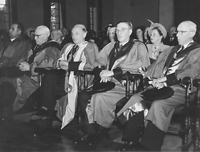


Developing dental education and research in Victoria
Introduction
Participants
Building a dental research culture
The influence of Frank Wilkinson
Developing linkages between the Dental School and Dental Hospital
The art and science of dentistry
The introduction and impact of fluoridation
Resolving a long-standing dispute with dental technicians
Training of dental health therapists
Dentistry's relationship with hospitals, government and industry
Controversy over the Dental School quota
The relationship between the School and the University of Melbourne
Relations between the School and the Australian Dental Association
The role of the School in childhood dental health
Funding research through the CRC and other programs
Personalities
Appendix; Some further thoughts stimulated by the Witness seminar
Endnotes
Index
Search
Help
Contact us

Henry Atkinson: I think when we start talking about science and practice, we have to be very careful because if you try to look at this objectively, youíll see that weíre still doing the same things today as we did a hundred years ago.
We havenít conquered the two diseases that we treat. So science has to take some sort of priority while practice goes along a parallel path. I donít think that they can both go together.
Ann Westmore: Can you elaborate on that. Firstly, what are the two diseases you think remain to be conquered.
Henry Atkinson: Speaking very broadly, dental caries and gum disease. Iím not including all the other conditions that appear in the mouth.
Maurice White: When fluoridation[53] was introduced, there was a drop in dental decay over the next ten years. But since that time, in the last twenty years, the level of dental caries has plateaued, in spite of all our dental health education, our training, and an oral hygiene industry worth about $304 million [annually] in Australia.
I think one of the problems connected to dental decay is that we leave food on our teeth every time after we eat. Thatís the source of the fermentable carbohydrate that causes problems. Unless we work out a mechanism to deal with that or prevent food getting caught in teeth such as with sealants - I donít know how Recaldent[54] is going, whether itís making any changes - but certainly the statistics you can find easily indicate that we havenít made any great change in the last twenty years.
John Harcourt: One of the problems is that people will drink bottled waterÖand fizzy drinks.
Garry Pearson: We should honour the work that was done by University people, in particular, and some others as well on the fluoride campaign, certainly through the 1960s and 1970s before that Act was introduced in 1973. We did honour Tony [Storey] amongst others when we had the 25th anniversary of Melbourneís fluoridation, and we had Sir Rupert Hamer[55] and John Thwaites[56] representing the bipartisan support.[57] Regrettably, Ted Baillieu[58] seems to have thrown that out of the window in the last week and opposed Geelongís fluoridation.
The fact that the University was so actively involved in that campaign, and many people made major contributions to public health in Victoria as a result, is a matter that should give everyone here some pride. Certainly I feel proud to have had some limited association with some of those involved well after all of that happened. Itís an honour to have been associated with a development that produced such benefits to so many millions of people.
Hector Orams: One could see the change in oneís own practice, of course. When I first went into dental practice in 1947 and also worked part-time at the Dental Hospital, the dentitions were shocking. People came with shocking mouths. It wasnít a matter of conserving them, you couldnít do anything with them.
When I left private practice in about 1964, the dentitions were improving due to better oral hygiene and improved diet. Like many dentists, I strongly recommended fluoride supplements in the form of tablets and, if my memory is not at fault, fluoridated toothpaste. With the introduction of fluoride into Melbourneís water supply in 1977 there was again further improvement. My own grandchildren donít seem to have dental caries. So I think fluoridation has had its effect, but then of course the effect is perhaps masked by better oral hygiene as well. And people are better educated and they are more interested in their teeth than they were 30 or 40 years ago.
Peter Reade: Thereís an interesting paradox with what Garry said in that Melbourne was also a major centre internationally for anti-fluoridation. My predecessor in the Chair [of Dental Medicine and Surgery] was one of the worldís best known anti-fluoridationists and his off-sider, whom I inherited as a staff member, was also opposed to it.
Peter Reade: My predecessor was Sir Arthur Amies[59] who was Dean of the Dental School and an oral surgeon. His off-sider was Phillip Sutton,[60] who did all the writing. They wrote a text-book and things of that kind. Phillip was sincere and thoughtful; we got on well. When Amies went, it was pretty clear that Sutton had acted to support him.

 |
Witness to the History of Australian Medicine |  |
© The University of Melbourne 2005-16
Published by eScholarship Research Centre, using the Web Academic Resource Publisher
http://witness.esrc.unimelb.edu.au/103.html